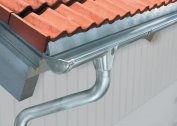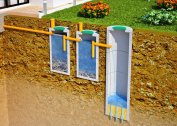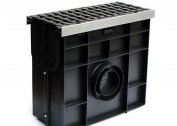A reinforced drainage is needed on a flat roof, because with heavy rainfall puddles form, which gradually destroy the waterproofing layer. In the room under the roof there are leaks on the walls. The second problem is dirt, the third is the seeds of plants that germinate in a humid environment and damage the coating with their roots. A way to get rid of puddles is special drain funnels.
Definition and purpose
Previously, a flat roof was an attribute of industrial buildings or multi-storey residential buildings. In the private sector, this useful area is used to equip a terrace in the summer, a sports ground and even a swimming pool. Often it has a fence - a parapet, because of which rainfall can not spontaneously leave the roof. For this, various methods of removing water were invented.
The drain funnel is designed to collect precipitation and direct it to drainpipes, and then to storm drains. In order for the liquid to get into the catchment, the roof must have a slope - absolutely flat roofs do not, since this leads to stagnation of water.
The central structural element must be reliably and tightly installed - the durability of the roofing depends on this. If part of it is damaged, another rain will cause destruction inside the building, which will lead to costly repairs and replacement of the entire coating.
Types and arrangement of drainage funnels
 There are two main types of drains:
There are two main types of drains:
- Traditional. Depths for funnels are laid during the construction of buildings. Their total number is calculated based on the roof area - an average of one per 25 square meters. A drainpipe adjoins directly to each funnel, then water flows into a common pipe. Precipitation method - external or internal, depends on the climate. In warm regions, the external type prevails, in countries with a cold climate - the internal type, which excludes freezing of precipitation.
- Gravity-vacuum system. The principle of operation is ejector: the air masses carry water along with it, and it moves down with great speed under the influence of gravity. It is not necessary to make a slope, since the liquid drains on its own under air pressure. For example: a vacuum system with a diameter of 75 mm can pass 15 liters of water per second, while a traditional design must have pipes with a diameter of 200 mm in order to handle the same volume. A smaller number of funnels and downpipes is required, which affects the cost.
The design of the drain funnel has the following device:
- board for receiving water - usually wide and with a slope to the center;
- a glass - is necessary to collect the liquid and send it down - into the pipe;
- a cap in the form of a grid with ribs is necessary so that leaves and various debris do not fall into the sewer.
If the roof is used for hanging out, choose flat funnels. Such models are relevant on roofs covered with tiles or a layer of asphalt. There are varieties of drainage funnels with electric heating, so that in winter precipitation does not freeze in the drainpipe. They are only metallic, since not all types of plastic can withstand high temperatures and begin to melt. Single-level or two-level models are used depending on the roof structure. Instead of a ruberoid apron, a crimp seam can serve as a fastening - a universal device for any material and roof structure.
Additional mounting accessories are rubber gaskets with bitumen, which provide reliable insulation. The pipe may be horizontal or vertical, depending on the type of drain. Glands are elements that prevent water from flowing out at the junction of the pipe and funnel.
Production material
 Masters recommend choosing a funnel so that its material of manufacture coincides with the roofing. For example, if the roof covering is copper, drain funnels must be selected from copper.
Masters recommend choosing a funnel so that its material of manufacture coincides with the roofing. For example, if the roof covering is copper, drain funnels must be selected from copper.
In addition to the most expensive and durable material - copper - funnels are made of cast iron, steel, plastic. There are also combined designs.
To equip a rigid roof, use cast-iron drainage funnels, steel, aluminum water inlets. Cast iron is a very strong and durable material. Its service life is more than 50 years. For the manufacture of roof elements, gray and alloy cast iron are used, which tolerate temperature extremes and are resistant to shock loads. For resistance to acid precipitation, funnels are coated with a special protective paint. The disadvantages of the material are its high price and high weight.
Stainless steel can last a long time, its carbon content should be low so that the material does not rust. The best option is steel interspersed with titanium and molybdenum. Such species better tolerate temperature extremes and the effects of precipitation of various chemical composition.
Thanks to the oxide film, the gutter funnel for a flat roof made of aluminum practically does not interact with the environment. The metal is durable and resistant to corrosion. Due to the ductility of aluminum during temperature changes, it does not cause roof deformations. The material is lightweight, so it does not cause installation difficulties, and also reduces the total weight of the roof.
Plastic funnels are used to equip a drain from flat roofs if the roof is made of soft materials. Polymers are absolutely not susceptible to corrosive processes, ultraviolet irradiation, due to the smooth surface they do not accumulate dirt - it is washed off during the first rain. Organic substances do not adhere to the material, and chemical components are not able to cause their destruction or deformation.
Based on plastic, combined funnels are made for drainage systems. This increases the life of the structure and makes it more resistant to environmental influences and mechanical damage.
How to choose
Funnels are selected based on the following factors:
- Temperature in the winter. If there are often frosts, it is better to use a cable to heat the system. In this way, ice accumulation and roof collapse can be avoided. You can only warm metal products. Cast iron and aluminum respond well to raising and lowering temperatures.
- In warm climates, aluminum is also a good option if the roof is made of solid materials. Plastic or combination products are suitable for any type of coating.
- The funnel must have a protective grill or cap against debris, otherwise the drainage system will become clogged and water will pour from the roof onto the wall, damaging the plaster. If the roof has a parapet, collapse under the weight of water is possible.
- According to the type of drain, a funnel is chosen if there is no place for horizontal drain under the roof. In this case, the pipes are mounted vertically down.
You need to pay attention to what type of waterproofing will be used on the roof. The material for the construction of the funnel must match the roof covering so that the structure can be hermetically sealed. The most commonly used rubber is bitumen coated, which is melted during installation with a gas burner and glued to a similar roofing material.
Installation Rules
When installing funnels, the following requirements must be considered:
- The quantity is calculated based on the area.On average - one per 200 square meters. At the same time, the pipe diameter should be at least 11 cm. It would be nice to make a replacement catchment basin in case the first one becomes clogged.
- It is necessary to observe the slope of the roof - at least 2%. The slope can be performed both to the center of the roof, and to the outer edge.
- When installing the water intake, a small space is left so that the materials do not deform the roof structure when the temperature regime changes.
- Depending on how many layers the roof waterproofing has, a bituminous apron is sealed between them in the middle or a piece of insulation material with a size of at least 1 square meter is additionally cut.
- During installation, additional fasteners are used - bolts, screws, if the funnel design is too light. The material must be made of stainless steel. For cast iron products, additional fastening is not required.
Stages of work on the roof of soft materials:
- The flooring of the lower layer of the roof is being carried out.
- A hole is cut along the diameter of the funnel.
- The material is heated by the burner to remove the protective film.
- The funnel is installed in its place.
- The apron is melted and glued to the bottom layer of the coating.
- If you plan to lay a second waterproofing "carpet", additional reinforcement of the apron is not required. If the coating is single-layer, a piece of rubber treated with bitumen is cut out, and the area around the funnel is closed by heating and gluing the materials.
At the end, a filter for garbage and leaves is installed.
Cost of drain funnels
The cost of water inlets is influenced by several factors. The more parts, the more expensive, since there must be tight joints between them. The size of the product plays a role: the price of the water intake funnel with a diameter of 100 mm will be one third more expensive than the cross section of 75 mm.
Metal products - steel, cast iron - are more expensive. Non-ferrous metals, especially copper, are valued more than all others.
At a cost, the most acceptable option is plastic or combined models. They are the most practical, since the soft material compensates for the expansion or reduction of the metal volume without violating the tightness, which is an important indicator of the quality of water receivers.




